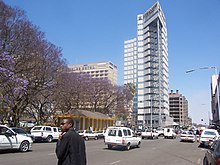
Back Ekonomie van Zimbabwe Afrikaans اقتصاد زيمبابوي Arabic জিম্বাবুয়ের অর্থনীতি Bengali/Bangla Economia de Zimbàbue Catalan Economi Simbabwe Welsh Wirtschaft Simbabwes German Economía de Zimbabue Spanish Économie du Zimbabwe French Economía de Cimbabue Galician Ekonomi Zimbabwe ID
 | |
| Currency | Zimbabwe Gold |
|---|---|
| calendar year | |
Trade organisations | AU, AfCFTA, WTO, SADC, COMESA |
Country group |
|
| Statistics | |
| Population | |
| GDP | |
| GDP rank | |
GDP growth | |
GDP per capita | |
GDP per capita rank | |
GDP by sector |
|
| 172.2% (2023 est.)[4] | |
Population below poverty line | |
| 44.3 medium (2017)[11] | |
Labour force | |
Labour force by occupation |
|
| Unemployment | |
Main industries | mining (coal, gold, platinum, copper, nickel, tin, clay, numerous metallic and non-metallic ores), steel; wood products, cement, chemicals, fertilizer, clothing and footwear, foodstuffs, beverages, cattle, cows |
| External | |
| Exports | |
Export goods | platinum, cotton, tobacco, gold, ferroalloys, textiles/clothing |
Main export partners |
|
| Imports | |
Import goods | machinery and transport equipment, other manufactures, chemicals, fuels, food products |
Main import partners |
|
FDI stock | |
Gross external debt | |
| Public finances | |
| −9.6% (of GDP) (2017 est.)[8] | |
| Revenues |
|
| Expenses | 5.5 billion (2017 est.)[8] |
| Economic aid | recipient: $178 million; note – the EU and the US provide food aid on humanitarian grounds (2000 est.) |

The economy of Zimbabwe is a gold standard based economy. Zimbabwe has a $44 billion dollar informal economy in PPP terms which translates to 64.1% of the total economy.[22] Agriculture and mining largely contribute to exports. The economy is set to reach $66 billion by end of 2023, 88% increase in forecast from $35 billion.[23][24]
The country has reserves of metallurgical-grade chromite. Other commercial mineral deposits include coal, asbestos, copper, nickel, gold, platinum and Iron ore.[25]
- ^ "World Economic Outlook Database, April 2019". IMF.org. International Monetary Fund. Archived from the original on 10 October 2020. Retrieved 29 September 2019.
- ^ "World Bank Country and Lending Groups". datahelpdesk.worldbank.org. World Bank. Archived from the original on 28 October 2019. Retrieved 29 September 2019.
- ^ "Zimbabwe Population(Live)". Worldometer.
- ^ a b c d "Zimbabwe Datasets". International Monetary Fund.
- ^ "Zim GDP Set To Reach US$66 Billion". TechnoMag. 2023-11-21. Retrieved 2024-01-17.
- ^ "2024 budget strategy paper: Zim's future looks bleak".
- ^ "Zim GDP hits US$66bn – the Herald".
- ^ a b c d e f g h i j "The World Factbook". CIA.gov. Central Intelligence Agency. Archived from the original on 26 January 2021. Retrieved 7 July 2019.
- ^ "Poverty headcount ratio at national poverty lines (% of population) – Zimbabwe". data.worldbank.org. World Bank. Archived from the original on 30 November 2020. Retrieved 21 March 2020.
- ^ "Poverty headcount ratio at $3.20 a day (2011 PPP) (% of population) – Zimbabwe". data.worldbank.org. World Bank. Archived from the original on 4 December 2019. Retrieved 21 March 2020.
- ^ "GINI index (World Bank estimate) – Zimbabwe". data.worldbank.org. World Bank. Archived from the original on 31 July 2020. Retrieved 21 March 2020.
- ^ "Human Development Index (HDI)". hdr.undp.org. HDRO (Human Development Report Office) United Nations Development Programme. Archived from the original on 27 June 2016. Retrieved 11 December 2019.
- ^ "Inequality-adjusted Human Development Index (IHDI)". hdr.undp.org. HDRO (Human Development Report Office) United Nations Development Programme. Archived from the original on 12 December 2020. Retrieved 11 December 2019.
- ^ "Labor force, total – Zimbabwe". data.worldbank.org. World Bank. Archived from the original on 1 August 2020. Retrieved 4 December 2019.
- ^ "Employment to population ratio, 15+, total (%) (national estimate) – Zimbabwe". data.worldbank.org. World Bank. Archived from the original on 4 December 2019. Retrieved 4 December 2019.
- ^ "Zimbabwe - export of goods 2012-2022".
- ^ "Zimbabwe | Imports and Exports | World | ALL COMMODITIES | Value (US$) and Value Growth, YoY (%) | 2011 - 2022". 28 January 2024.
- ^ "Zimbabwe - import of goods 2012-2022".
- ^ "Zimbabwe | Imports and Exports | World | ALL COMMODITIES | Value (US$) and Value Growth, YoY (%) | 2011 - 2022". 28 January 2024.
- ^ "Zimbabwe committed to debt reduction". www.reuters.com.
- ^ "Zimbabwe Plans 14-Fold Increase in Spending to Aid Economy". Bloomberg. 30 November 2023.
- ^ "Zimbabwe". World Economics. Retrieved 2024-01-17.
- ^ "Zim GDP hits US$66bn – The Herald". www.herald.co.zw. Retrieved 2024-01-17.
- ^ "Zim GDP Set To Reach US$66 Billion". TechnoMag. 2023-11-21. Retrieved 2024-01-17.
- ^ "Southern African Development Community :: Zimbabwe". sadc.int. Archived from the original on 31 August 2018. Retrieved 31 August 2018.
© MMXXIII Rich X Search. We shall prevail. All rights reserved. Rich X Search